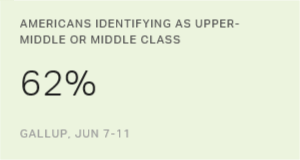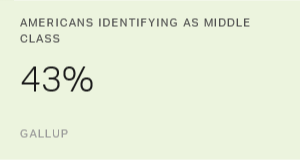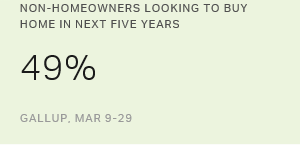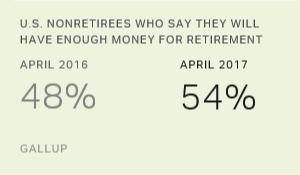Story Highlights
- 62% identify as upper-middle or middle class, similar to 2008
- Just 2% of Americans identify as upper class
- Older adults much more likely than young adults to identify as middle class
WASHINGTON, D.C. -- The breakdown of social class identification in the U.S. has returned to pre-recession levels, with 2% saying they belong to the upper class, 62% to the upper-middle or middle classes, and 36% to the working or lower classes.
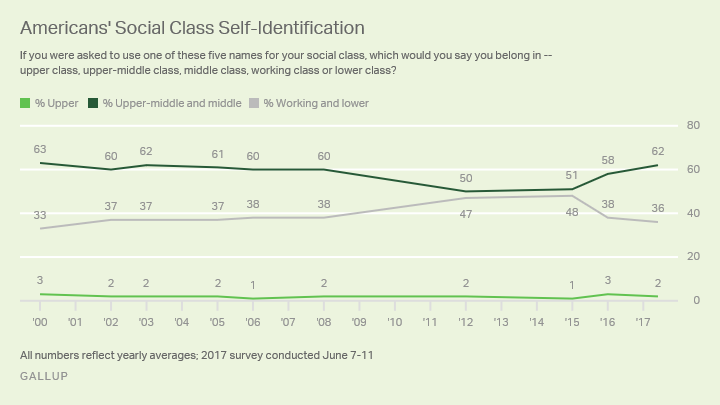
Americans' identification as upper-middle or middle class was lower in 2012 and 2015, but rose across three surveys taken last fall, and has edged up slightly more in Gallup's June 7-11 poll.
Gallup's class identification question asks Americans to put themselves in one of five categories: upper, upper-middle, middle, working or lower class. This subjective classification differs from objective calculations of social class based on quantifiable measures like income, education, net worth, location of residence, family background or other variables.
Middle class is the most common label, used by 44% of Americans, followed by working class at 28% and upper-middle class at 18%. Relatively few consider themselves to be lower class or upper class, at 8% and 2%, respectively.
Gallup did not ask this social class question between 2009 and 2011, and therefore it is possible the 2012-2015 dip in middle-class identification was evident earlier, following the 2008 financial meltdown and its aftermath. Overall, the three 2016 surveys and the current June 7-11 survey demonstrate that subjective social class identification has stabilized close to the prevailing pattern observed before 2009.
Previous Gallup research shows that the decline of middle-class identifiers in the 2012 and 2015 surveys compared with 2008, plus the subsequent rebound in 2016 (which has continued in 2017), was evident across all income levels but was more pronounced among those without a college degree.
Age is related to subjective social class, with about half of young Americans in the most recent study identifying as working or lower class, significantly more than among those who are older. Americans 65 and older are in turn significantly more likely to identify as middle class than those who are younger.
These differences could reflect a tendency for older people to avoid the term "working class" because many are no longer employed. Younger Americans may be less likely to identify as middle class because they are more likely to be in school, are less likely to own a home and have lower incomes -- with the last of these highly related to social class identity.
| 18 to 29 | 30 to 49 | 50 to 64 | 65+ | ||||||||||||||||||||||||||||||||||||||||||||||||||||||||||||||||||||||||||||||||||||||||||||||||
|---|---|---|---|---|---|---|---|---|---|---|---|---|---|---|---|---|---|---|---|---|---|---|---|---|---|---|---|---|---|---|---|---|---|---|---|---|---|---|---|---|---|---|---|---|---|---|---|---|---|---|---|---|---|---|---|---|---|---|---|---|---|---|---|---|---|---|---|---|---|---|---|---|---|---|---|---|---|---|---|---|---|---|---|---|---|---|---|---|---|---|---|---|---|---|---|---|---|---|---|
| % | % | % | % | ||||||||||||||||||||||||||||||||||||||||||||||||||||||||||||||||||||||||||||||||||||||||||||||||
| Upper class | 1 | 3 | 1 | 3 | |||||||||||||||||||||||||||||||||||||||||||||||||||||||||||||||||||||||||||||||||||||||||||||||
| Upper-middle and middle class | 50 | 59 | 66 | 77 | |||||||||||||||||||||||||||||||||||||||||||||||||||||||||||||||||||||||||||||||||||||||||||||||
| Working and lower class | 49 | 38 | 33 | 19 | |||||||||||||||||||||||||||||||||||||||||||||||||||||||||||||||||||||||||||||||||||||||||||||||
| Gallup, June 7-11, 2017 | |||||||||||||||||||||||||||||||||||||||||||||||||||||||||||||||||||||||||||||||||||||||||||||||||||
Upper-middle- and middle-class identification among the youngest age group has remained much more stable than among those who are older, and the drop in 2012 and 2015 was evident in all age groups except those 18 to 29. Subsequently, upper-middle- and middle-class identification jumped between 11 and 17 percentage points among age groups 30 and older from the 2012-2015 low point to the current survey; among 18- to 29-year-olds, by contrast, middle-class identification is up only three points.
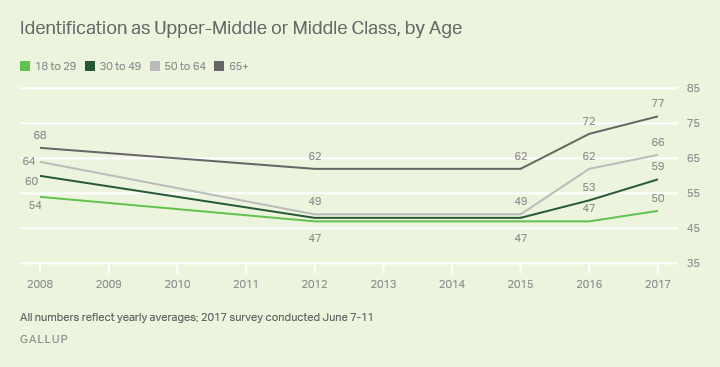
Implications
Despite evidence of rising income inequality in recent years, Americans are no more likely now than in the past to identify themselves at the high or low ends of the social class hierarchy. Furthermore, few Americans call themselves upper class, and the percentage who choose the upper-middle-class label is not materially higher than it was from 2000 through 2008.
Similarly, the percentage of Americans who place themselves in the lower- or working-class categories is about the same today as it was in the years 2008 and before. Thus, the evidence here doesn't suggest that a sharp decline in the middle class, or a rise in the working class, was related to Donald Trump's election success last year.
Overall, "middle class" is the label Americans use more than any other to describe their social class, providing a useful catchphrase for politicians interested in appealing to the broadest swath of the public.
Historical data are available in Gallup Analytics.
Survey Methods
Results for this Gallup poll are based on telephone interviews conducted June 7-11, 2017, with a random sample of 1,009 adults, aged 18 and older, living in all 50 U.S. states and the District of Columbia. For results based on the total sample of national adults, the margin of sampling error is ±4 percentage points at the 95% confidence level. All reported margins of sampling error include computed design effects for weighting.
Each sample of national adults includes a minimum quota of 70% cellphone respondents and 30% landline respondents, with additional minimum quotas by time zone within region. Landline and cellular telephone numbers are selected using random-digit-dial methods.
View survey methodology, complete question responses and trends.
Learn more about how the Gallup Poll Social Series works.
